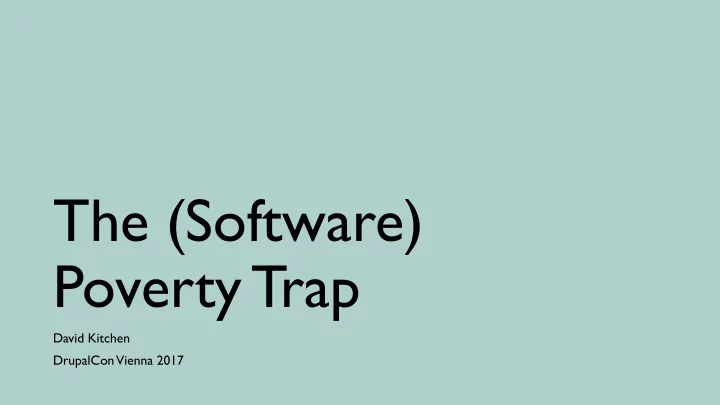

The (Software) Poverty Trap David Kitchen DrupalCon Vienna 2017
Disclaimers • These are my own views and not those of Johnson & Johnson • Choice of characters for each role is based on availability of artwork • Apologies for any British cultural references
A Story About Poverty & Debt
Jim
Great Grandfather Agricultural Laborer Grandfather Agricultural Laborer Great Grandmother Father Agricultural Laborer Great Grandfather Agricultural Laborer Grandmother Great Grandmother Jim Miner Miner Mother Cleaner Domestic Servant
A poverty trap is "any self-reinforcing mechanism which causes poverty to persist." If it persists from generation to generation, the trap begins to reinforce itself if steps are not taken to break the cycle. Wikipedia
Poverty Traps for Countries for Companies • Conflict • Culture and Retention • Natural resources • Buyer/Supplier Monopoly • Landlocked Countries • Bad Governance • Bad Governance The four poverty traps defined in The Bottom Billion by Paul Collier
A debt spiral refers to a situation where an individual (or firm or country) sees ever-increasing levels of debt. This increasing levels of debt and debt interest becomes unsustainable, eventually leading to debt default.
A Similar Story?
Rosie
v 0.1
v 0.3
v 1.0
“After Scrum adoption, the most visible symptoms of dysfunction in our software development department were related to agile engineering practices, where teams were accumulating a huge amount of technical debt.” Visualizing and Managing T echnical Debt in Agile Development: an Experience Report Paulo Sérgio Medeiros dos Santos; Federal University of Rio de Janeiro, System Engineering and Computer Science Department Amanda Varella, Cristine Ribeiro Dantas, & Daniel Beltrão Borges; Petrobras, Exploitation and Production Business Solutions Agile Processes in Software Engineering and Extreme Programming: 14th International Conference, XP 2013, Vienna, Austria, June 3-7, 2013, Proceedings
How do you feel about the technical debt on your current project?
Financial Thinking
In software-intensive systems, technical debt is a collection of design or implementation constructs that are expedient in the short term, but set up a technical context that can make future changes more costly or impossible. T echnical debt presents an actual or contingent liability whose impact is limited to internal system qualities, primarily maintainability and evolvability. The 16162 definition of Technical Debt As defined at the Dagstuhl Managing T echnical Debt in Software Engineering Seminar, April 2016 http://www.dagstuhl.de/16162
What is Technical Debt? Principle Interest Debt
Principle, the cost to repay • Initial Principle savings gained by taking some initial approach or shortcut in development • Current Principle the cost that it would now take to develop a different or better solution
Interest, the cost of not repaying • Recurring interest additional cost of incurred by the project because of the technical debt • Accruing interest additional cost developing new software depending on not- quite-right code
Types of Debt
Mortgage Low rate of interest Possibly a big principle Code formatting • • Code smells
Loan Higher rate of interest Performance issues • Documentation •
Credit Card Initial interest free period, followed by high interest Acceptable interest for a short period Quick fixes • Business opportunity •
Measure and Track Your Debt
Burn Up Chart 60 50 40 30 20 10 0 0 1 2 3 4 5 6 Story Points
Business Balance Sheet Assets Fixed Assets 10,000 Current Assets 8,000 T otal Assets 18,000
Business Balance Sheet Assets Fixed Assets 10,000 Current Assets 8,000 T otal Assets 18,000 Liabilities Creditors falling due within one year 4,000 Creditors falling due after one year 15,000 T otal Liabilities 19,000 Net Assets (1,000)
Velocity vs. Debt 60 40 20 0 0 1 2 3 4 5 6 -20 -40 -60 -80 Story Points Debt
Velocity vs. Debt 50 40 30 20 10 0 0 1 2 3 4 5 6 -10 -20 Story Points Debt
Good Financial Management
Your Agile Project Needs a Budget, Not an Estimate by Debbie Madden 29 Dec 2014
Depreciation • Debt incurs Interest • Value Depreciates • Competition • Needs change
The Sunk Cost Fallacy The Misconception The Reality You make rational decisions based Your decisions are tainted by the on the future value of objects, emotional investments you investments and experiences accumulated, and the more you invest in something the harder it becomes to abandon it. Bankruptcy might be the best option
Further Information • T echDebt 2018: The inaugural TechDebt Conference will be held jointly with the International Conference on Software Engineering 2018 in Gothenburg, Sweden, May 27–28, 2018 • Managing T echnical Debt Workshop Series 2010 to 2017 Archive • The Software Development Poverty Trap, Alexandros Marinos; original inspiration for this presentation
Please review the session: https://events.drupal.org/vienna2017/sessions/software-poverty-trap David Kitchen Senior Software Engineering Manager Johnson & Johnson @dwkitchen david@dwkitchen.com
Recommend
More recommend